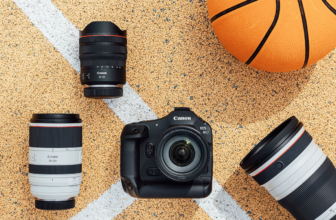The Canon EOS R6 II is a 24MP full-frame camera aimed at enthusiast photographers and video shooters. It may look identical to its predecessor on the outside, but it gains useful new features for stills and video while providing a refined shooting experience.
Key specifications
- 24.2MP CMOS sensor
- 12fps mechanical shutter (40fps electronic shutter)
- Built-in image stabilization rated to 8.0 stops
- 4K/60p video (oversampled from 6K)
- 6K ProRes RAW video with a compatible Atomos recorder
- Raw burst mode with pre-capture
- Moving subject HDR mode
- 3.68M-dot EVF capable of up to 120 fps refresh (0.76x magnification)
- 1.62M-dot, 3-inch rear touchscreen
- Dual UHS-II SD card slots
- 580 shot-per-charge battery rating (CIPA)
Initial impressions
The EOS R6 II is, predictably, a refined version of the original EOS R6. Where the R6 was a solid camera, the R6 II gives a sense of being a more well-rounded product with the potential to appeal to a broader range of users.
In one sense, the R6 II may be Canon’s best current example of a Swiss Army Knife type of camera: it doesn’t excel at any one thing to the point of becoming a specialty or niche product, but it has the potential to do an awful lot of things exceptionally well. It certainly benefits from the fact that Canon now has several years of mirrorless EOS development under its belt, paving the way for a more advanced mid-level camera.
After shooting thousands of frames on a pre-production R6 II over a couple of days, I came away with the sense that it can be a pretty fast camera. Fast is relative: the R6 II doesn’t have a stacked sensor like the R3 (and at this price point, I wouldn’t expect it to), but if you need to shoot quickly, 40fps will get you there, and I was pleasantly surprised at how infrequently rolling shutter artifacts showed up in images from fast-moving sports.
Of course, that 40fps works partly because the R6 II benefits from Canon’s excellent mirrorless AF system, which has now had a few years to mature. Even on a pre-production body, I found it surprisingly responsive, often taking only a split second to lock onto a fast-moving target like a BMX bike flying into the frame from the side. The fact that the AF system now has a recognition mode to detect different types of subjects makes this an even smoother experience.
Many of the improvements to this camera come from improved workflows for stills or video. For example, the Raw burst mode has the potential to be a real time saver. The ability to step through each burst, smartphone-style, and pick one or two keepers from each sequence while planted in an airplane seat is appealing. Similarly, the ability to pre-buffer photos before pressing the shutter button, as other camera systems can do, can be a huge help when things are about to move quickly.
Canon seems intent on improving video workflows as well. In addition to improved video specs and better thermal management, tools like a video-centric Q menu, false color display, and the ability to pre-buffer video for up to five seconds should appeal to videographers. This also adds to the mystery of why Canon hasn’t addressed one of the more common complaints from video shooters: the inability to use the histogram or level gauge once recording starts.
The EOS R6 II is a very capable camera that ticks a lot of boxes. The original R6 was a solid camera, too; in fact, we recommended it in our buying guide as the best camera for around $2000 for a long time, so the fact that the R6 II improves in some critical areas while adding useful new tools is a very good sign. I look forward to getting my hands on a full production model and pushing it further, shooting a more diverse range of subjects and finding out just how much it can do.
How it compares
The EOS R6 II slots into one of the most competitive segments of the full-frame camera market: mid-level models aimed at enthusiasts or even pros.
The R6 II seems to hit its sweet spot in this group at the performance end of the spectrum. Canon’s well-regarded AF system and 40fps electronic shutter give it a leg up. It’s also strong on the video front, delivering oversampled 4K/60p from the full width of its sensor and support for a 6K Raw (external) workflow.









